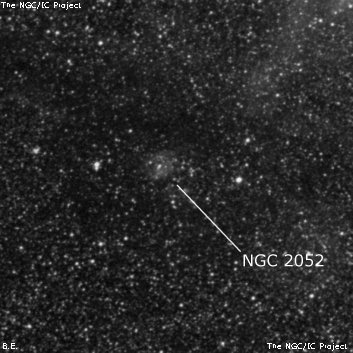
John Herschel discovered NGC 2052 = h2929 in 1834-1835 (sweep number and date unknown as based on a sketch of the Tarantula Nebula (NGC 2070) region made over several nights in Nov 1834 and Dec 1835) and described as "vvF, vvL, vglbM." Herschel changed the description in the GC to read "eF, vvS, vglbM" (probably an error) and this was copied by Dreyer into the NGC. His position is 2.5' SW of the faint HII region Henize N155, which the Hodge-Wright Atlas and the ESO identify as NGC 2052. There are no other nearby candidates. Harold Corwin suggests "NGC 2052 may be the large diffuse nebula 2 minutes of time preceding JH's position. But it may not be."
Eric Lindsay, in the 1964 paper "Some NGC objects in the Large Magellanic Cloud" (IAJ, 6, 286-289), notes "Should be 2.3m E of NGC 2033. It may be a small group slightly NE in which is Henize N155. Dreyer and Herschel differ as to size [actually Herschel changed the size]. Position measured by Herschel from a drawing and not during a sweep."
300/350mm - 14" (4/4/16 - Coonabarabran, 145x): without a filter this emission nebula (N155) is a very faint, small patch perhaps 35" diameter, only a couple of faint stars are involved. Situated midway between a mag 12 star 2' W and a mag 12.5 star 2' ENE.
Notes by Steve Gottlieb